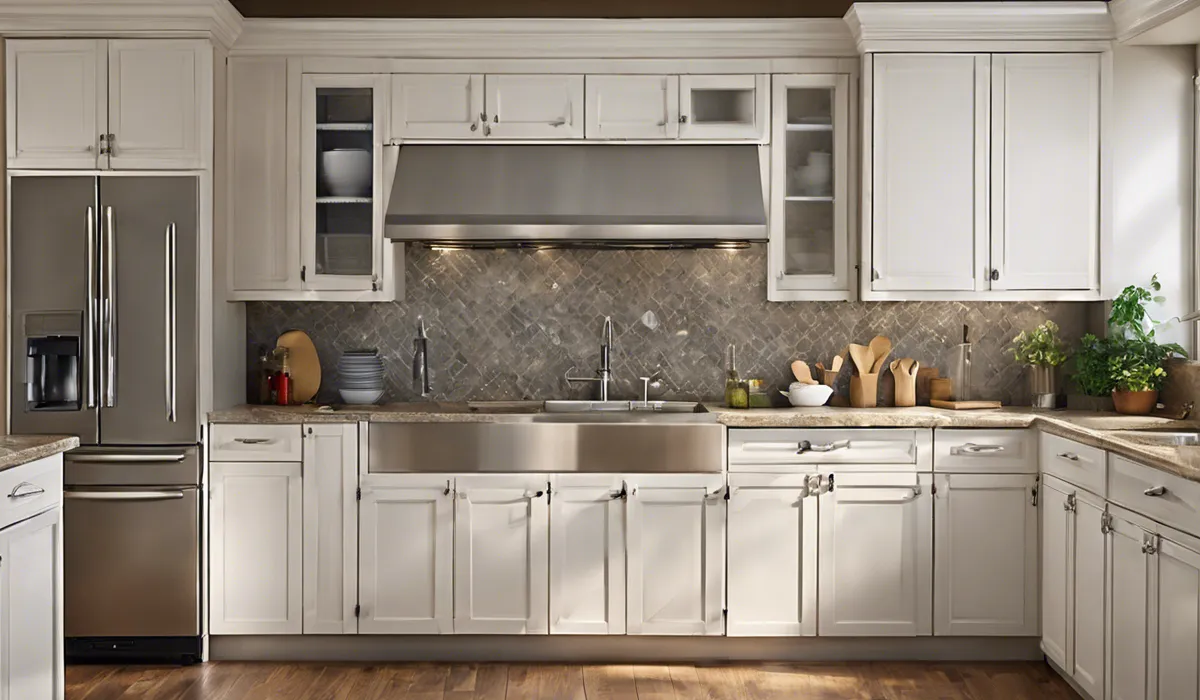How to Protect Cabinets from Dishwasher Steam: Guarding Tips
To protect cabinets from dishwasher steam, install a moisture barrier or heat shield between the dishwasher and cabinets. Ensure proper dishwasher ventilation and regularly check and replace worn seals or gaskets. Consider using cabinet door heat deflectors to safeguard the cabinet finish.
Understanding the Impact of Dishwasher Steam on Cabinets

How Dishwashers Generate Steam
Dishwashers clean dishes by spraying them with hot water and then drying them with heat. During the drying phase, steam is produced as the hot water evaporates.
The steam rises, and if the dishwasher is positioned next to cabinets, this moist air can come into contact with cabinet surfaces, potentially causing damage over time.
Cabinet Materials Vulnerable to Steam
Many cabinets are made from materials like wood, particleboard, or MDF, which can be sensitive to moisture.
Steam can seep into these materials, causing them to expand, warp, or develop mold. Some finishes and paints may also be compromised by prolonged exposure to moisture, leading to peeling or discoloration.
Signs of Steam Damage on Cabinets
Indications that cabinets are suffering from steam damage include warping or bubbling of the cabinet doors, discoloration, and a musty smell indicative of mold growth.
The finish on the cabinets may also start to peel away, and you might notice that the cabinet doors do not close properly due to warping.
Preventive Measures to Protect Cabinets

Installing Steam Deflectors or Moisture Barriers
To shield cabinets from the damaging effects of steam, consider installing a steam deflector or moisture barrier between the dishwasher and the cabinetry.
This barrier redirects steam away from cabinet surfaces, preventing moisture accumulation and potential damage.
Proper Dishwasher Installation and Ventilation
Ensuring that your dishwasher is correctly installed with enough space for ventilation is critical. The dishwasher should have clear pathways to release steam, reducing the chances of it affecting the surrounding cabinetry.
Additionally, always use the dishwasher according to the manufacturer’s instructions to minimize steam production.
Maintenance of Steam Vents and Seals
Regularly inspect and maintain your dishwasher’s steam vents and door seals. Worn or damaged seals can allow steam to escape in unintended directions, so replace them when necessary to keep the steam contained within the dishwasher until it’s properly vented.
Choosing Moisture-Resistant Cabinet Materials
When selecting new cabinets or replacing old ones, opt for materials known for their resistance to moisture, such as stainless steel or high-quality laminates.
These materials can better withstand the effects of steam and are less likely to sustain damage.
Remedial Actions for Affected Cabinets

Cleaning and Repairing Minor Steam Damage
If you notice early signs of steam damage, you can clean and repair the affected areas. This might involve gently sanding down the warped or bubbled surfaces and refinishing them.
If mold is present, clean the area with a mold-killing solution and allow it to dry completely before sealing and refinishing.
When to Seek Professional Restoration
For significant damage, it might be necessary to seek professional restoration services.
They can assess the extent of the damage and provide solutions that may not be possible with DIY methods, such as reconstructing parts of the cabinetry or applying industrial-grade finishes.
Refinishing or Replacing Cabinet Parts
If the damage is beyond repair, you may need to refinish or replace the affected cabinet parts.
Refinishing involves stripping the old finish, sanding the surfaces, and applying a new finish. If the damage is structural, replacing the damaged parts or the entire cabinet may be the only viable solution.
FAQs About Protecting Cabinets from Dishwasher Steam
How can I install a moisture barrier to protect my cabinets from dishwasher steam?
You can install a moisture barrier by placing a protective sheet or panel between the dishwasher and the adjacent cabinets, ensuring it’s secured and covers the necessary areas completely.
What type of heat shield is best for preventing steam damage to cabinets?
A heat shield designed for kitchen use, often made from insulating materials like foil-covered bubble insulation, is best for preventing steam damage to cabinets.
How do I ensure proper dishwasher ventilation to avoid steam damage?
Ensure that the dishwasher is properly installed with adequate space for airflow and that it is not tightly enclosed by cabinetry, which could trap steam.
How often should I check and replace my dishwasher seals or gaskets to protect my cabinets?
Regularly inspect your dishwasher seals or gaskets every 3 to 6 months and replace them if you notice wear and tear to prevent steam from escaping.
What are cabinet door heat deflectors and how do they protect cabinet finishes from dishwasher steam?
Cabinet door heat deflectors are accessories that can be installed to redirect steam away from cabinet finishes, thus protecting the surface from heat and moisture damage.
Final Thoughts
To shield cabinets from the steam of a dishwasher, install a moisture barrier or heat shield and ensure the dishwasher is well-ventilated.
Regular maintenance, such as inspecting and replacing seals or gaskets, is crucial. Additionally, cabinet door heat deflectors can be employed to protect the cabinet’s finish from heat damage.





